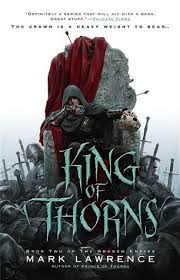
2‑King of Thorns
Chapter 45: Four years earlier
by Mark, Lawrence,The chapter “44: Four Years Earlier” serves as a flashback, providing critical context for the events unfolding in *King of Thorns*, the second installment of *The Broken Empire* series. It revisits a pivotal moment in the protagonist’s past, shedding light on his motivations and the formative experiences that shaped his ruthless persona. The narrative shifts tone to explore the protagonist’s earlier struggles, offering readers a deeper understanding of his complex character and the origins of his ambition.
The flashback reveals a younger, less hardened version of the protagonist, grappling with challenges that foreshadow his future as a formidable leader. Through vivid storytelling, the chapter highlights key encounters and decisions that set him on a path of conquest and vengeance. The prose is gritty and immersive, reflecting the harsh realities of the Broken Empire’s world, where survival often demands brutality and cunning.
Themes of power, betrayal, and resilience are central to this chapter. The protagonist’s interactions with allies and adversaries alike underscore the precarious nature of trust in his world. The narrative delves into his psychological evolution, illustrating how trauma and adversity forged his iron will. The chapter’s title, “Four Years Earlier,” emphasizes the temporal shift, inviting readers to draw connections between past and present events.
Ultimately, this chapter enriches the overarching narrative by deepening the protagonist’s backstory. It balances action with introspection, offering a nuanced portrayal of a character who is both a product of his environment and a master of it. The flashback serves as a reminder that the protagonist’s reign as the King of Thorns is rooted in a history of struggle and survival, adding layers of complexity to his journey.
FAQs
1. What is the significance of the chapter title “44: Four years earlier” in King of Thorns: Book Two of the Broken Empire?
Answer:
The chapter title “44: Four years earlier” suggests a flashback or a shift in the narrative timeline, indicating that the events in this chapter occurred four years prior to the main storyline. This technique is often used to provide background, context, or character development. In King of Thorns, such a temporal shift likely serves to reveal critical past events that shape the protagonist’s motivations, decisions, or relationships, deepening the reader’s understanding of the broader plot and character arcs.2. How does the structure of this chapter (a brief, standalone section) contribute to the storytelling in King of Thorns?
Answer:
The concise and standalone nature of this chapter may serve as a narrative pivot or a moment of reflection. By isolating this segment, the author creates emphasis, drawing attention to a specific event or revelation that holds significance for the larger story. This technique can heighten suspense, provide clarity, or offer a thematic contrast to surrounding chapters. In King of Thorns, such brevity might underscore a pivotal moment in the protagonist’s past, leaving a lasting impact on the reader.3. What thematic or symbolic elements might be inferred from the sparse content of this chapter?
Answer:
The minimalistic content of the chapter could symbolize fragmentation, memory, or the elusive nature of truth—themes often explored in The Broken Empire series. The lack of detailed exposition may mirror the protagonist’s fractured psyche or the unreliable nature of his recollections. Alternatively, it might represent a deliberate narrative choice to leave room for interpretation, inviting readers to engage critically with the text and piece together deeper meanings from subtle clues.4. How might this chapter’s placement in the book affect the reader’s understanding of the protagonist’s journey?
Answer:
If “44: Four years earlier” is positioned as a flashback, its placement likely serves to contextualize the protagonist’s present actions or mindset. By revealing key past events at a strategic point in the narrative, the author can create dramatic irony, foreshadowing, or emotional resonance. For example, learning about a formative experience from four years earlier could explain the protagonist’s current conflicts, alliances, or moral dilemmas, enriching the reader’s engagement with his character development.5. In what ways does this chapter challenge or subvert traditional fantasy storytelling conventions?
Answer:
The chapter’s brevity and ambiguity subvert the expectation of elaborate world-building or exposition typical in fantasy. Instead of spoon-feeding details, the author trusts the reader to infer meaning, aligning with the series’ gritty, unconventional tone. This approach mirrors the protagonist’s often morally ambiguous and unpredictable nature, reinforcing the series’ theme of a “broken” world where clarity is scarce. Such storytelling choices reflect a modern, literary approach to fantasy, prioritizing psychological depth over traditional tropes.
Quotes
1. “King of Thorns: Book Two of the Broken Empire”
This opening line sets the tone for the chapter, establishing the dark, regal, and conflict-driven themes of the narrative. It immediately signals the continuation of a larger saga centered on power struggles and moral ambiguity.
2. “44: Four years earlier”
This temporal marker is significant as it frames the chapter as a flashback, providing crucial context for the events unfolding in the main narrative. It suggests a pivotal moment in the protagonist’s past that shapes their current trajectory.
